A Novel Multi-Element Resonant Converter with Self-Driven Synchronous Rectification
Abstract
:1. Introduction
2. Circuit Description and Principle Operation
- (1)
- All semiconductors, layout trace and the copper losses of the transformer are lossless.
- (2)
- The turns ratio of the transformer windings is n = N1/N2.
- (3)
- The output capacitance CO is large enough so that the output voltage VO is a constant value.
- (4)
- The magnetizing inductance of the transformer is large enough compared to other resonant components so it can approximate an open-circuit.
3. Design Consideration and Experimental Results
4. Conclusions
Author Contributions
Funding
Conflicts of Interest
References
- Tran, D.; Vu, N.; Choi, W. A Quasi-Resonant ZVZCS Phase-Shifted Full-Bridge Converter with an Active Clamp in the Secondary Side. Energies 2018, 11, 2868. [Google Scholar] [CrossRef]
- Bo, Y.; Lee, F.C.; Zhang, A.J.; Guisong, H. LLC Resonant Converter for Front End DC/DC Conversion. In Proceedings of the APEC 2002, Dallas, TX, USA, 10–14 March 2002; Volume 2, pp. 1108–1112. [Google Scholar]
- Choi, H. Analysis and Design of LLC Resonant Converter with Integrated Transformer. In Proceedings of the APEC 2007, Anaheim, CA, USA, 25 February–1 March 2007; pp. 1630–1635. [Google Scholar]
- Zhu, T.; Wang, J.; Ji, Y.; Liu, Y. A Novel High Efficiency Quasi-Resonant Converter. Energies 2018, 11, 1961. [Google Scholar] [CrossRef]
- Pernía, A.M.; Prieto, M.J.; Villegas, P.J.; Díaz, J.; Martín-Ramos, J.A. LCC Resonant Multilevel Converter for X-ray Applications. Energies 2017, 10, 1573. [Google Scholar] [CrossRef]
- Yu, A.; Zeng, X.; Xiong, D.; Tian, M.; Li, J. An Improved Autonomous Current-Fed Push-Pull Parallel-Resonant Inverter for Inductive Power Transfer System. Energies 2018, 11, 2653. [Google Scholar] [CrossRef]
- Fang, X. Efficiency-oriented optimal design of the LLC resonant converter based on peak gain placement. IEEE Trans. Power Electron. 2013, 28, 2285–2296. [Google Scholar] [CrossRef]
- Lu, B.; Liu, W.; Liang, Y.; Lee, F.C.; van Wyk, J.D. Optimal design methodology for LLC resonant converter. In Proceedings of the Twenty-First Annual IEEE Applied Power Electronics Conference and Exposition, Dallas, TX, USA, 19–23 March 2006; pp. 533–538. [Google Scholar]
- Fei, C.; Li, Q.; Lee, F.C. Digital Implementation of Adaptive Synchronous Rectifier (SR) Driving Scheme for High-Frequency LLC Converters With Microcontroller. IEEE Trans. Power Electron. 2018, 33, 5351–5361. [Google Scholar] [CrossRef]
- Fang, Z.; Cai, T.; Duan, S.; Chen, C. Optimal design methodology for LLC resonant converter in battery charging applications based on time-weighted average efficiency. IEEE Trans. Power Electron. 2015, 30, 5469–5483. [Google Scholar] [CrossRef]
- Kim, D.K.; Moon, S.C.; Yeon, C.O.; Moon, G.W. High-efficiency LLC resonant converter with high voltage gain using an auxiliary LC resonant circuit. IEEE Trans. Power Electron. 2016, 31, 6901–6909. [Google Scholar] [CrossRef]
- Zhao, Z.; Xu, Q.; Dai, Y.; Yin, H. Analysis, Design, and Implementation of Improved LLC Resonant Transformer for Efficiency Enhancement. Energies 2018, 11, 3288. [Google Scholar] [CrossRef]
- Khalid, U.; Khan, M.M.; Khan, M.Z.; Rasool, M.A.U.; Xu, J. Pulse Width and Frequency Hybrid Modulated LLC Converter Adapted to Ultra Wide Voltage Range. Inventions 2018, 3, 77. [Google Scholar] [CrossRef]
- Xie, X.; Liu, J.; Poon, F.N.K.; Pong, M. A novel high frequency current-driven SR applicable to most switching topologies. IEEE Trans. Power Electron. 2001, 16, 635–648. [Google Scholar]
- Zhang, S.-H.; Wang, Y.-I.; Chen, B.; Han, F.-U.; Wang, Q.-I. Studies on a Hybrid Full-Bridge/Half-Bridge Bidirectional CLTC Multi-Resonant DC-DC Converter with a Digital Synchronous Rectification Strategy. Energies 2018, 11, 227. [Google Scholar] [CrossRef]
- Huang, D.; Fu, D.; Lee, F.C. High switching frequency, high efficiency CLL resonant converter with synchronous rectifier. In Proceedings of the 2009 IEEE Energy Conversion Congress and Exposition, San Jose, CA, USA, 20–24 September 2009; pp. 804–809. [Google Scholar]
- Chang, Y.-N.; Chan, S.-Y.; Cheng, H.-L. A Single-Stage High-Power Factor Converter with Synchronized Self-Excited Technique for LED Lighting. Energies 2018, 8, 1408. [Google Scholar] [CrossRef]
- Huang, D.; Fu, D.; Lee, F.C.; Fu, D. Classification and selection methodology for multi-element resonant converters. In Proceedings of the 2011 Twenty-Sixth Annual IEEE Applied Power Electronics Conference and Exposition (APEC), Fort Worth, TX, USA, 6–11 March 2011; pp. 558–565. [Google Scholar]
- Chen, M.; Wang, Y.; Yang, L.; Han, F.; Hou, Y.; Yan, H. A Variable-Structure Multi-Resonant DC–DC Converter with Smooth Switching. Energies 2018, 11, 2240. [Google Scholar] [CrossRef]
- Wang, C.; Yang, L.; Wang, Y.; Chen, B. A 1-kw CLTCL resonant DCDC converter with restricted switching loss and broadened voltage range. IEEE Trans. Power Electron. 2018, 33, 4190–4203. [Google Scholar] [CrossRef]
- Wang, Y.; Yang, L.; Han, F.; Tu, S.; Zhang, W. A Study of Two Multi-Element Resonant DC-DC Topologies with Loss Distribution Analyses. Energies 2017, 19, 1400. [Google Scholar] [CrossRef]
- Fu, D.; Lee, F.C.; Liu, Y.; Xu, M. Novel multi-element resonant converters for front-end dc/dc converters. In Proceedings of the 2008 IEEE Power Electronics Specialists Conference, Rhodes, Greece, 15–19 June 2008; pp. 250–256. [Google Scholar]
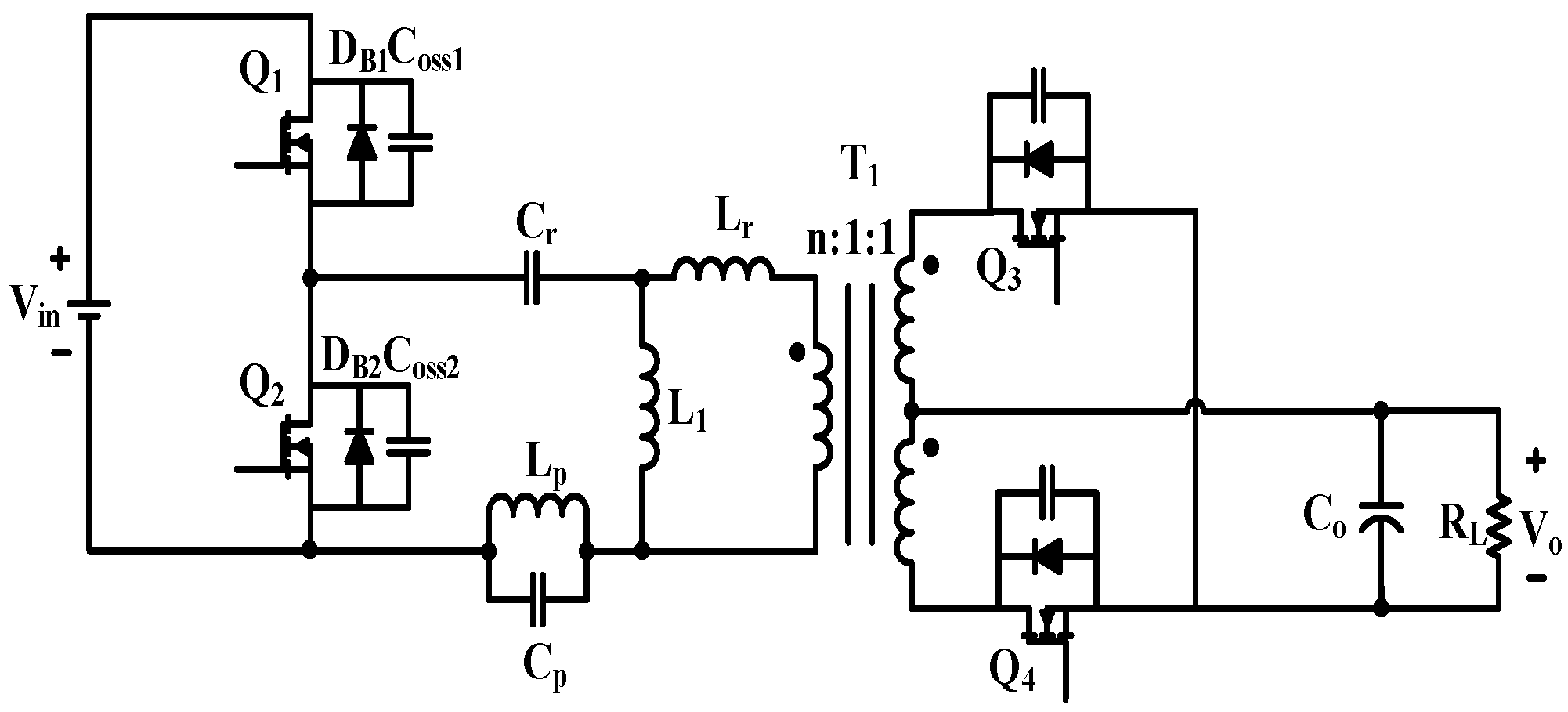



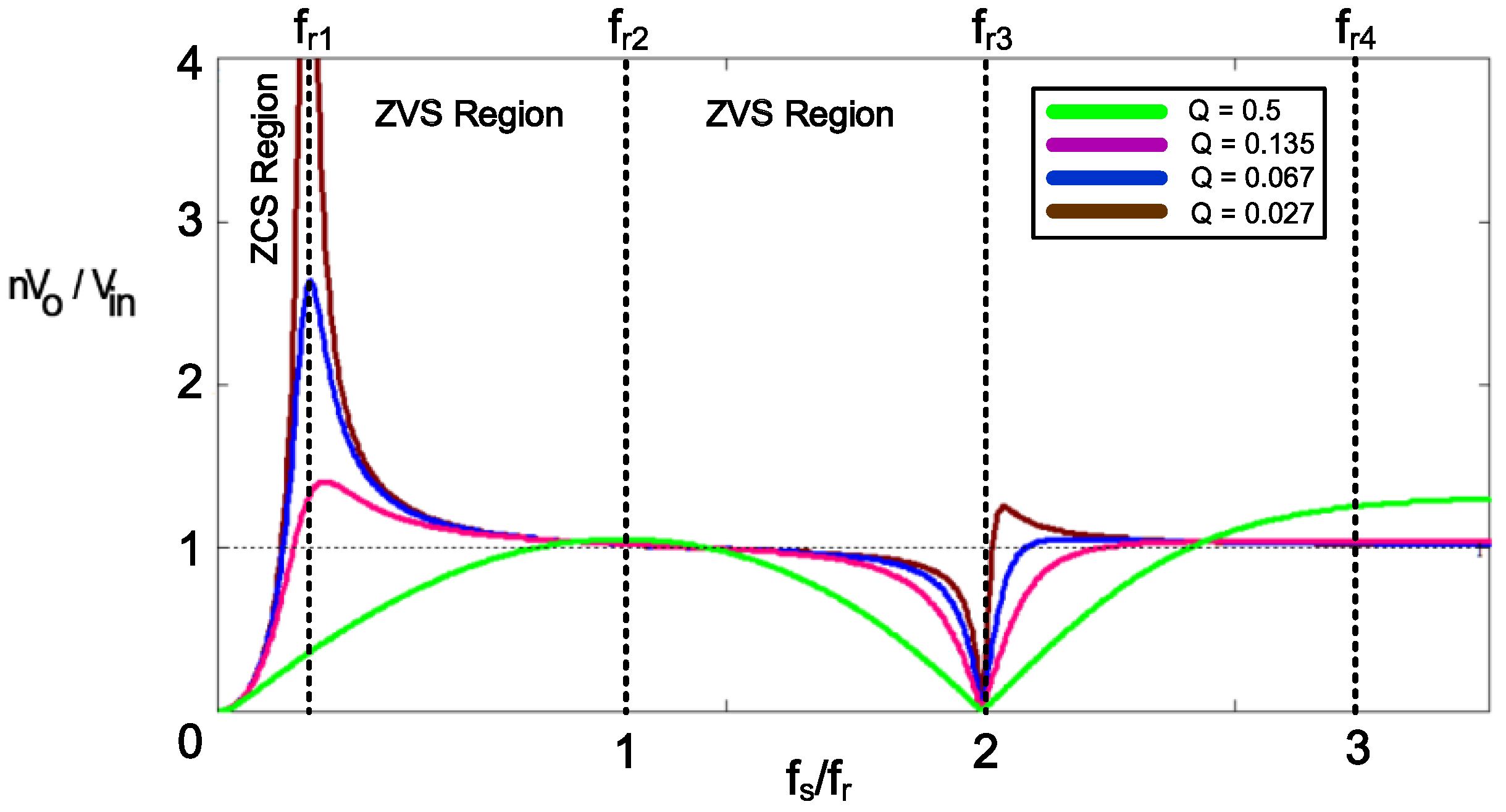

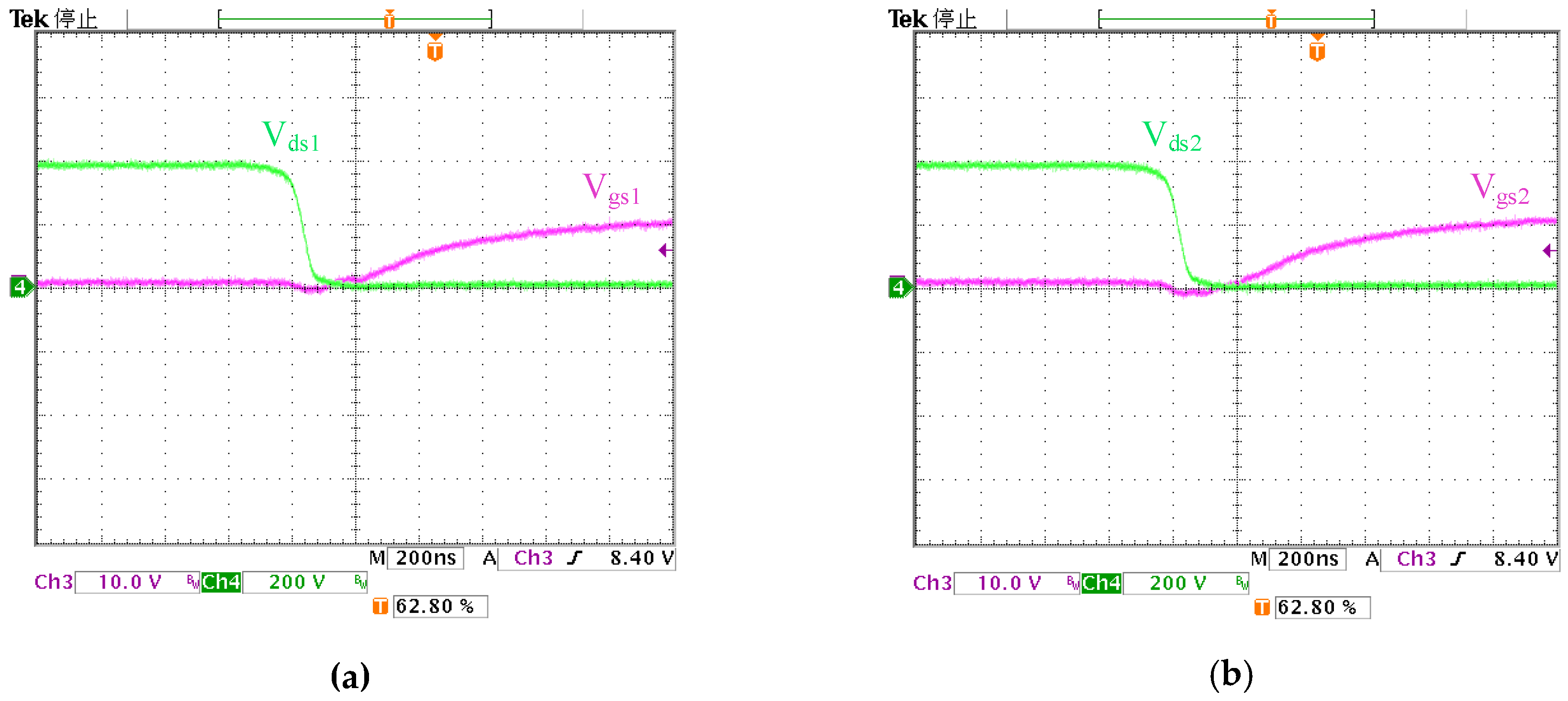

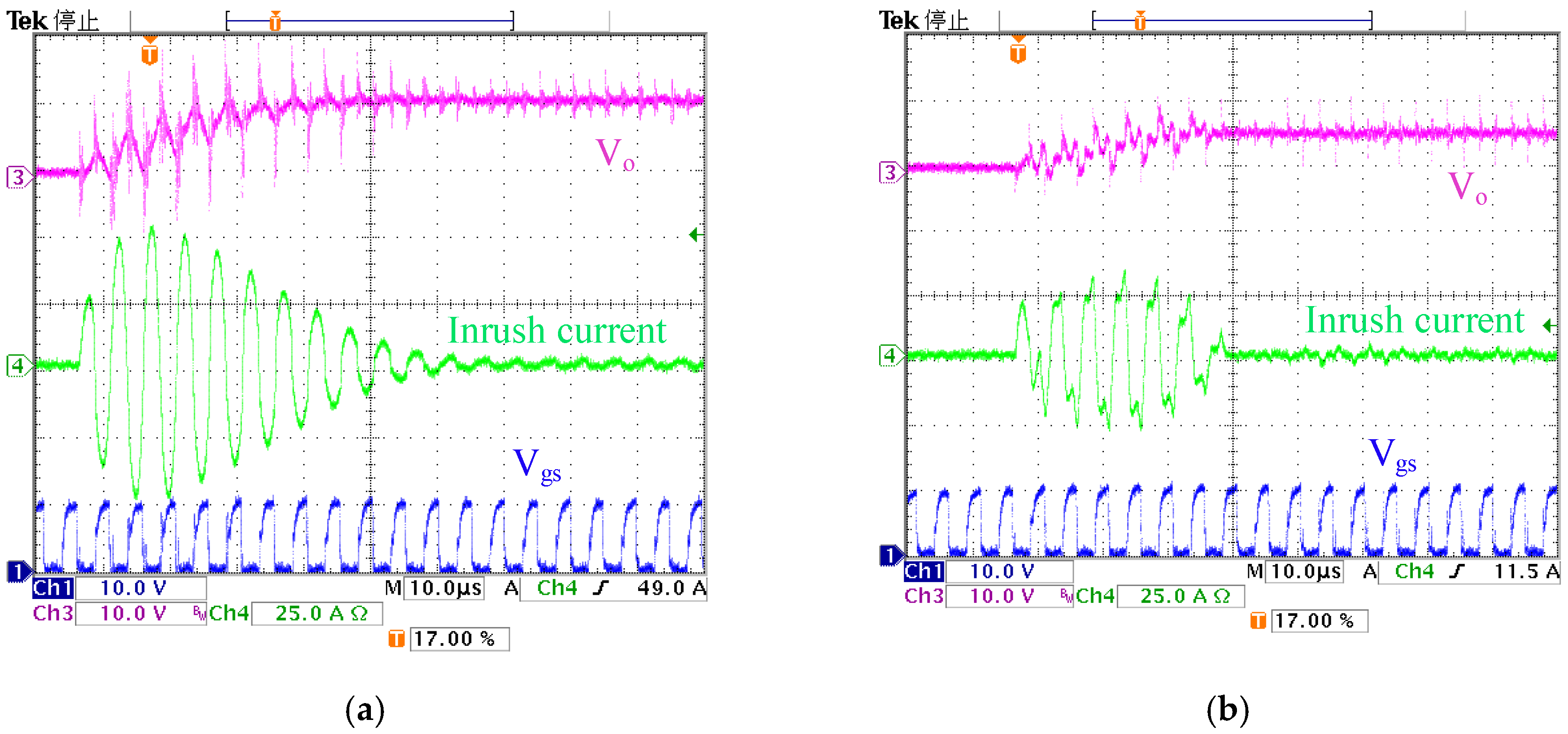
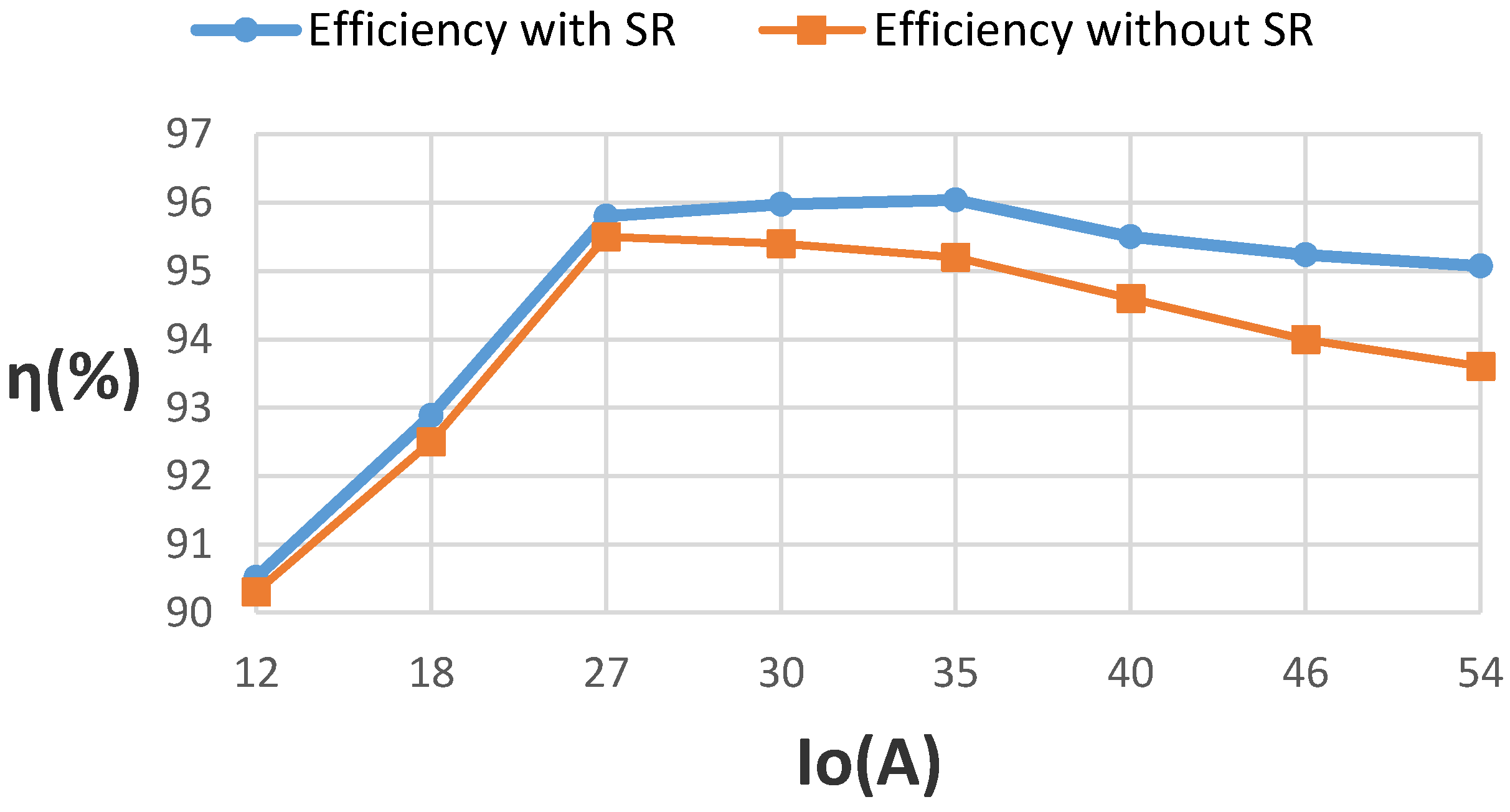
| Item | , | , | , , , | |
| Voltage Stress | ||||
| Current Stress (Peak-Current) |
| Item | LLC Converter | Proposed Converter |
|---|---|---|
| Power device | 4 | 4 |
| Resonant tank elements | 3 | 5 |
| SR detecting circuit | Complex | Simple |
| Over current protect | Difficult | Simple |
| Inrush current | Large | Middle |
| Conversion efficiency | High | High |
| Resonant frequency fr0 | 15.3 kHz |
| Resonant frequency fr1 | 72.8 kHz |
| Resonant frequency fr2 | 150.2 kHz |
| Resonant frequency fr3 | 225.6 kHz |
© 2019 by the authors. Licensee MDPI, Basel, Switzerland. This article is an open access article distributed under the terms and conditions of the Creative Commons Attribution (CC BY) license (http://creativecommons.org/licenses/by/4.0/).
Share and Cite
Lin, J.-Y.; Lin, Y.-F.; Lee, S.-Y. A Novel Multi-Element Resonant Converter with Self-Driven Synchronous Rectification. Energies 2019, 12, 715. https://doi.org/10.3390/en12040715
Lin J-Y, Lin Y-F, Lee S-Y. A Novel Multi-Element Resonant Converter with Self-Driven Synchronous Rectification. Energies. 2019; 12(4):715. https://doi.org/10.3390/en12040715
Chicago/Turabian StyleLin, Jing-Yuan, Yi-Feng Lin, and Sih-Yi Lee. 2019. "A Novel Multi-Element Resonant Converter with Self-Driven Synchronous Rectification" Energies 12, no. 4: 715. https://doi.org/10.3390/en12040715





